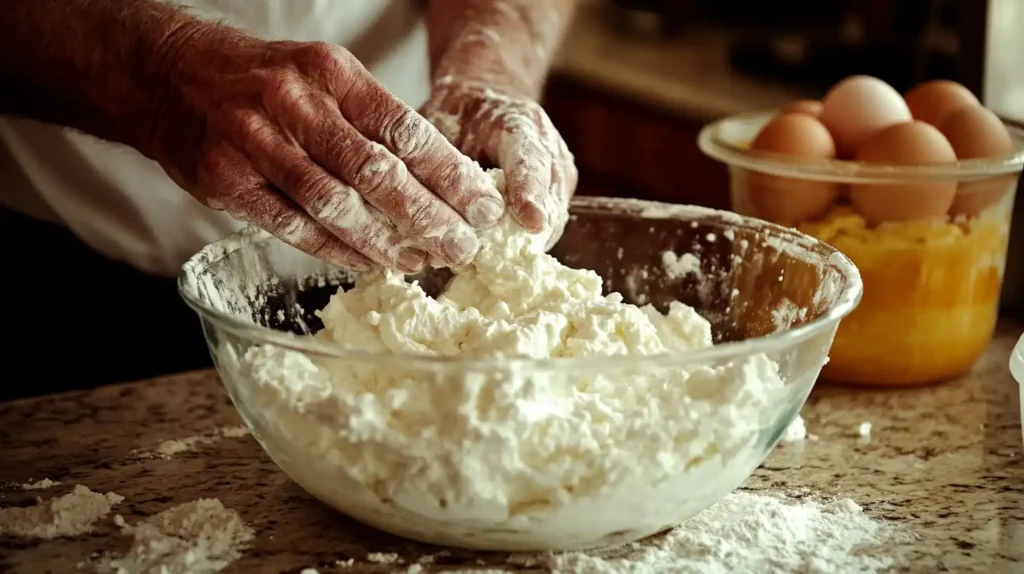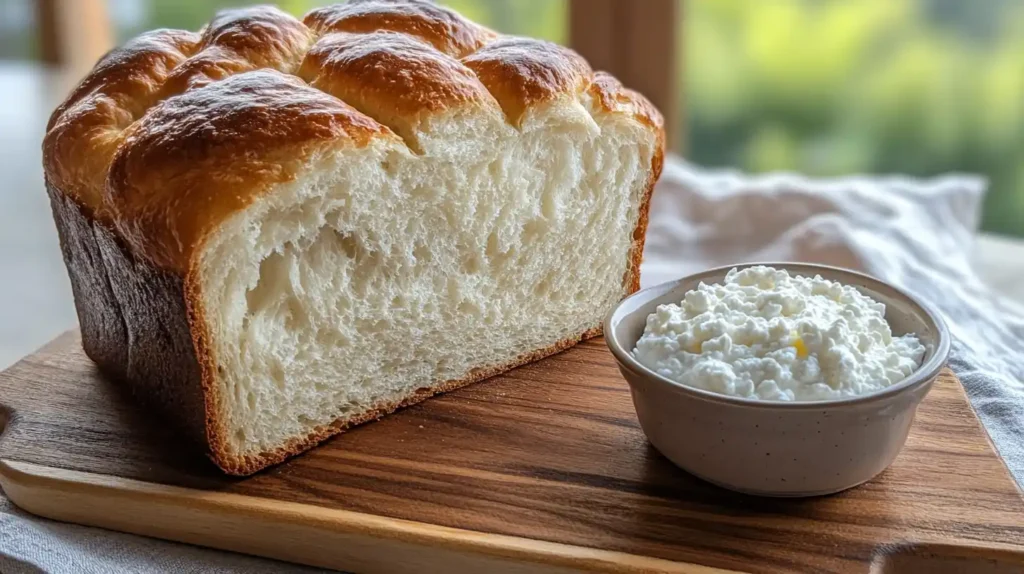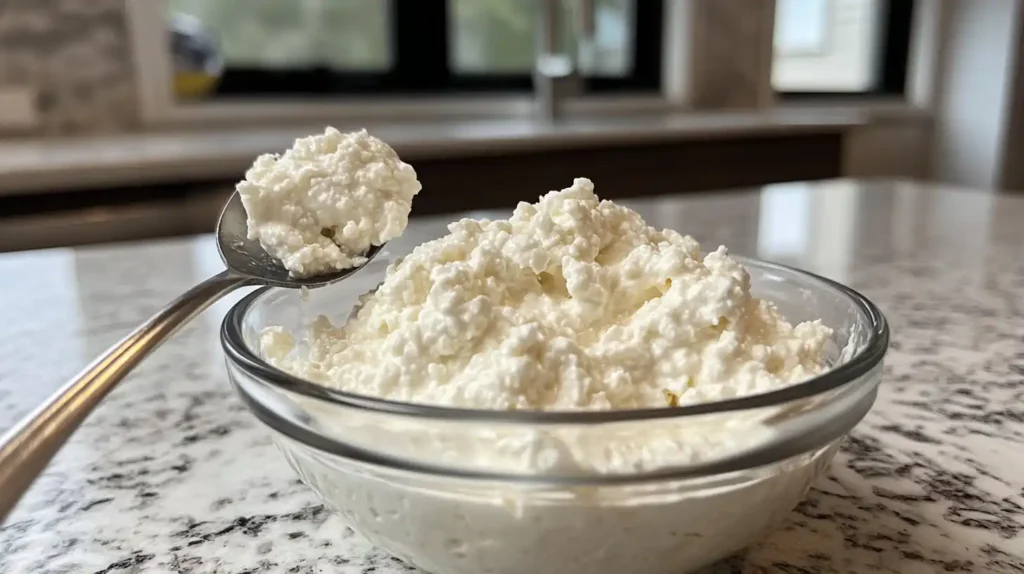Baking is both a science and an art, where every ingredient plays a crucial role. One such ingredient that has gained popularity in recent years is cottage cheese. But why do you use cottage cheese in baking? This versatile dairy product enhances texture, boosts nutrition, and adds a unique flavor to baked goods. Whether you’re making muffins, cheesecakes, or breads, cottage cheese can be a game-changer.
Before diving into the benefits, it’s important to understand what makes cottage cheese a great addition to baking. Unlike other dairy ingredients, it brings a high-protein, low-fat alternative while keeping moisture levels balanced. If you’re looking for a healthier yet delicious way to elevate your baked treats, cottage cheese is the answer.

What is Cottage Cheese?
Cottage cheese is a soft, fresh cheese made from curdled milk. Unlike hard cheeses, it does not age, which gives it a mild, creamy, and slightly tangy flavor. It is packed with protein, calcium, and essential nutrients, making it a healthy and versatile ingredient for baking.
How is Cottage Cheese Made?
The process of making cottage cheese is simple:
- Milk is heated until it starts to curdle.
- An acid or enzyme (like lemon juice or rennet) is added to separate the curds from the whey.
- The curds are drained and rinsed to remove excess whey.
- A bit of salt is sometimes added for flavor.
Since cottage cheese is fresh and unaged, it has a soft texture and a slightly grainy consistency. Depending on the variety, it can have small or large curds.
Different Types of Cottage Cheese for Baking
Not all cottage cheese is the same. Choosing the right type can affect your baked goods.
- Small-curd cottage cheese – Great for smooth batters and blending into cakes.
- Large-curd cottage cheese – Ideal for chunky textures in breads and muffins.
- Low-fat or fat-free cottage cheese – A lighter option for healthier baking.
- Full-fat cottage cheese – Adds extra creaminess and richness.
Because cottage cheese is mild in taste, it works well in both sweet and savory recipes.
Why Use Cottage Cheese in Baking?
There are several reasons why bakers incorporate cottage cheese into their recipes. Here’s what makes it a standout ingredient:
1. Enhances Texture & Moisture
- The curds in cottage cheese create a light, fluffy texture in baked goods.
- It keeps cakes and muffins from drying out, thanks to its high moisture content.
- When blended, it adds a creamy consistency, making it a great alternative to heavier dairy ingredients.
2. A High-Protein Baking Alternative
For a high-protein twist on your favorite baked goods, consider using cottage cheese as a substitute. It’s an excellent ingredient for protein-rich pancakes, muffins, and even cheesecakes. If you’re wondering about the health benefits of blueberry pancakes, Gain insights about: Are Blueberry Pancakes Good for You?
3. A Low-Fat Substitute
- Want to make your baked goods healthier without sacrificing taste? Cottage cheese is a fantastic replacement for:
- Butter – Lowers the fat content while maintaining richness.
- Cream Cheese – Makes cheesecakes and frostings lighter.
- Sour Cream & Heavy Cream – Offers a creamy consistency without excess calories.
4. A Naturally Mild & Versatile Flavor
- Unlike ricotta or feta, cottage cheese has a subtle, neutral taste.
- It pairs well with both sweet and savory recipes.
- The slight tanginess can enhance the flavor depth in baked treats.
How Cottage Cheese Compares to Other Dairy Ingredients
Many recipes use dairy to create a rich texture and moist crumb. But how does cottage cheese compare to other common baking ingredients like cream cheese, ricotta, Greek yogurt, and sour cream? Let’s take a closer look!
1. Cottage Cheese vs. Cream Cheese in Baking
Both cottage cheese and cream cheese are creamy, but they have key differences.
| Feature | Cottage Cheese | Cream Cheese |
|---|---|---|
| Texture | Soft, grainy curds | Smooth and thick |
| Moisture | High moisture content | Lower moisture |
| Fat Content | Lower fat | Higher fat |
| Best For | Lighter cheesecakes, muffins | Traditional cheesecakes, frostings |
Cottage cheese is a lower-fat alternative to cream cheese. Blending it creates a smooth, creamy texture, perfect for cheesecakes and frostings.

2. Cottage Cheese vs. Ricotta Cheese in Baking
Ricotta and cottage cheese look similar, but they behave differently in baking.
| Feature | Cottage Cheese | Ricotta Cheese |
|---|---|---|
| Texture | Grainy, slightly firm | Creamier, smoother |
| Moisture | High moisture | High moisture |
| Fat Content | Lower fat | Higher fat |
| Best For | Muffins, pancakes, lighter cakes | Lasagnas, Italian desserts |
If you need a healthier, protein-rich alternative, cottage cheese is a good substitute for ricotta in recipes like pancakes and muffins.
3. Cottage Cheese vs. Greek Yogurt in Baking
Greek yogurt is a popular dairy ingredient, but can cottage cheese replace it?
| Feature | Cottage Cheese | Greek Yogurt |
|---|---|---|
| Texture | Chunky, curds | Smooth, thick |
| Moisture | High | High |
| Fat Content | Low-fat and full-fat options | Low-fat and full-fat options |
| Best For | Cakes, muffins, creamy bakes | Cakes, muffins, breads |
Both ingredients add moisture and protein, but cottage cheese has a milder flavor and a lighter texture. If blended, it can replace Greek yogurt in baking.
4. Cottage Cheese vs. Sour Cream in Baking
Sour cream is often used in baking to add moisture. Can cottage cheese do the same?
| Feature | Cottage Cheese | Sour Cream |
|---|---|---|
| Texture | Chunky, curdy | Smooth, creamy |
| Moisture | High | High |
| Fat Content | Lower fat | Higher fat |
| Best For | Cakes, muffins, breads | Moist cakes, biscuits |
If you want less fat but the same creamy texture, replace sour cream with blended cottage cheese. It works well in cakes, muffins, and savory bakes.
Which Dairy Ingredient Should You Choose?
| If You Want… | Use This Ingredient |
|---|---|
| A thick, creamy texture | Cream cheese |
| A smooth, soft consistency | Ricotta cheese |
| A tangy, protein-rich boost | Greek yogurt |
| A moist, buttery flavor | Sour cream |
| A healthy, low-fat alternative | Cottage cheese |
Cottage cheese is the best option if you want low-fat, high-protein baking. When blended, it acts like cream cheese or sour cream, but with fewer calories and more nutrients.
Best Cottage Cheese Baking Recipes
Cottage cheese is a fantastic ingredient for baking. It improves texture, adds moisture, and boosts nutrition. Whether making a cake, muffins, or bread, it can enhance the final result. Here are some of the best baked goods that benefit from cottage cheese.
1. Cottage Cheese Pancakes – Fluffy and Protein-Packed
Pancakes made with cottage cheese turn out extra soft and light. The curds help create a fluffy texture, while the protein keeps you full longer. Unlike traditional pancakes, these have a natural creaminess that reduces the need for extra butter.
How to use cottage cheese in pancakes:
- Blend it for a smooth batter or keep the curds for texture.
- Combine with eggs, flour, and a little honey for a simple, healthy recipe.
- Pair with fresh fruit or maple syrup for added sweetness.
2. Cottage Cheese Muffins – Moist and Healthy
Muffins can sometimes become dry, but cottage cheese helps maintain moisture. It works well in both sweet and savory versions, blending easily with chocolate chips, berries, or nuts.
How to use cottage cheese in muffins:
- Replace butter or oil with blended cottage cheese for a lighter texture.
- Mix it with whole wheat flour and bananas for a nutritious breakfast muffin.
3. Cottage Cheese Cheesecake – A Lighter Version
Cheesecake made with cottage cheese has a creamy texture but is lower in fat than traditional versions. The mild flavor pairs well with vanilla, lemon, or chocolate.
How to use cottage cheese in cheesecake:
- Blend it until smooth for a silky filling.
- Combine with eggs, a little sugar, and vanilla for a classic base.
- Use a graham cracker crust for the best results.
If you want to master the best techniques, Get the details about ultimate guide to making the perfect cottage cheese bake.
4. Cottage Cheese Banana Bread – Extra Moist and Soft
Banana bread stays soft and fluffy with cottage cheese in the batter. It also adds protein without changing the sweet, comforting banana flavor.
How to use cottage cheese in banana bread:
- Mix it directly into the batter as a substitute for butter or yogurt.
- Use overripe bananas for natural sweetness.
5. Cottage Cheese Bread – High-Protein and Savory
Adding cottage cheese to bread dough makes it soft and rich. It also increases protein, making homemade bread more nutritious. This works especially well with whole wheat flour or oats.
How to use cottage cheese in bread:
- Add it to the dough mixture for extra softness.
- Pair with herbs, garlic, or cheddar for a savory twist.
6. Cottage Cheese Cookies – A Soft, Unique Twist
Cookies made with cottage cheese turn out soft and chewy. This dairy ingredient adds moisture without needing too much butter.
How to use cottage cheese in cookies:
- Blend it until smooth before mixing it into cookie dough.
- Pair it with honey, cinnamon, or dark chocolate for extra flavor.
7. Cottage Cheese Casseroles – A Savory Baking Essential
For casseroles, cottage cheese is an excellent base for a creamy, protein-rich dish. It blends well with vegetables, eggs, and seasonings for a balanced meal.
How to use cottage cheese in casseroles:
- Use it instead of ricotta in lasagna for a lighter texture.
- Mix it with eggs and vegetables for a fluffy baked dish.
Why Cottage Cheese Works So Well in Baking
This ingredient improves baked goods in many ways. It keeps cakes and muffins moist while adding protein and nutrients. It also replaces high-fat ingredients like butter and cream cheese without affecting flavor. Since it works well in both sweet and savory recipes, it is one of the most versatile dairy products for baking.
Common Mistakes When Baking with Cottage Cheese & How to Avoid Them
Using cottage cheese in baking is a great way to improve texture, add moisture, and boost nutrition. However, if not used correctly, it can cause problems like a watery batter, an odd texture, or an unbalanced flavor. Here are some of the most common mistakes bakers make when using cottage cheese—and how to fix them.

1. Over-Blending Cottage Cheese Until It Becomes Watery
Blending cottage cheese helps create a smooth consistency, but blending it too much can turn it watery. This happens because the curds break down completely, releasing moisture.
How to avoid this mistake:
- If a smooth texture is needed, pulse blend instead of mixing at high speed.
- Drain excess liquid before blending to keep the consistency thicker.
- For recipes where texture doesn’t matter, use cottage cheese as-is.
2. Using the Wrong Type of Cottage Cheese
Not all cottage cheese is the same. Using the wrong type can change the texture of your baked goods.
How to avoid this mistake:
- For smooth batters (like cheesecakes or pancakes), use small-curd cottage cheese or blend large-curd varieties.
- For chunky textures (like bread or muffins), large-curd cottage cheese works best.
- For lower-fat baking, choose low-fat or fat-free options, but be aware they contain more liquid.
3. Not Adjusting for Extra Moisture
Cottage cheese has a high water content, which can make batters too wet if not balanced properly.
How to avoid this mistake:
- If the batter feels too thin, add a little extra flour or oats.
- Drain cottage cheese in a strainer if using full-fat versions.
- If replacing cream cheese or sour cream, slightly reduce other liquids in the recipe.
4. Skipping Flavor Adjustments
Cottage cheese has a slightly tangy and salty taste. If used in the wrong recipe, this flavor can be noticeable.
How to avoid this mistake:
- For sweet recipes, balance the tanginess with a little honey, maple syrup, or vanilla extract.
- For savory recipes, pair it with herbs, garlic, or black pepper to enhance the flavor.
- Always taste test the batter before baking to check for flavor balance.
5. Expecting Cottage Cheese to Act Like Cream Cheese
While cottage cheese can be a substitute for cream cheese in some recipes, they are not identical. Cottage cheese has more moisture and a grainier texture, which can affect the final product.
How to avoid this mistake:
- Blend it extra smooth when using it as a cream cheese replacement.
- Mix in a tablespoon of Greek yogurt or cornstarch to thicken the consistency.
- Use it in lighter cheesecakes or frostings rather than dense, rich ones.
6. Not Storing Cottage Cheese Baked Goods Properly
Since cottage cheese has a high moisture content, baked goods made with it can spoil faster if not stored correctly.
How to avoid this mistake:
- Store cottage cheese baked goods in an airtight container to prevent drying out.
- Keep them at room temperature for up to a day, then refrigerate.
- For longer storage, freeze muffins, pancakes, or breads for up to a month.
7. Using It Without Proper Mixing Techniques
If cottage cheese is not mixed properly, it can lead to uneven texture, with some parts being too dry or too wet.
How to avoid this mistake:
- Mix it thoroughly before incorporating it into the batter.
- If blending, make sure it is fully incorporated into the mix.
- Fold it in gently for breads, muffins, and pancakes to avoid over-mixing.
FAQs: People Also Ask
Can I Replace Milk with Cottage Cheese in Baking?
Yes! Blended cottage cheese can be a substitute for milk or buttermilk in certain recipes, adding creaminess and protein.
Does Cottage Cheese Make Baked Goods Healthier?
Absolutely! It reduces fat while increasing protein and calcium, making baked goods more nutritious.
What’s the Best Way to Store Cottage Cheese Baked Goods?
To prevent drying out, store them in an airtight container at room temperature for a day or refrigerate for up to 5 days.
Can You Use Cottage Cheese Instead of Butter?
Yes! It can be blended into recipes as a low-fat butter alternative, but results may be slightly different in texture.
Final Thoughts
So, Why is cottage cheese used in baking? Because it offers moisture, nutrition, and a fantastic texture while being a low-fat, high-protein alternative. Whether you’re making breads, muffins, or cheesecakes, this versatile ingredient can transform your baking.
Next time you’re whipping up a batch of muffins or baking a cake, consider reaching for cottage cheese. Not only will it make your treats healthier, but it will also elevate their texture and flavor. Give it a try you might just find your new favorite secret ingredient! 🎂✨

